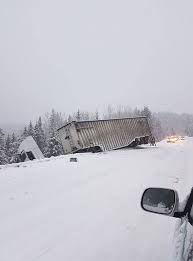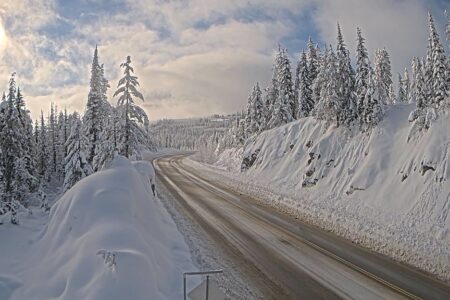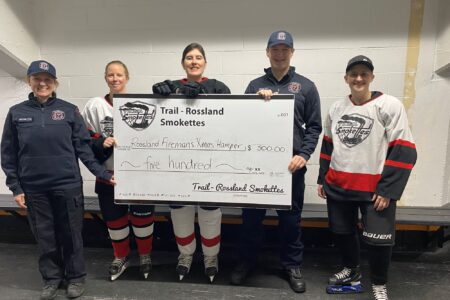MoT sends delegation to discuss local conditions and crashes
A delegation from the Ministry of Transportation (MoT) attended Castlegar City Council Monday evening to discuss local road conditions and MoT’s Shift into Winter campaign.
They spoke at length about resources available to assist motorists in making safe decisions and driving to conditions (see links below) and reporting adverse conditions to Emcon and the province, but essentially said there only significant change we can expect from an operational perspective is a series of changes to the contractor specifications (local contracts are slated to be renewed in October 2018).
Councillor Deb McIntosh challenged the panel with questions about a spate of recent fatalities on Hwy 22.
“As you know, Hwy 22 has posed a lot of problems this year, and we’ve heard a number of complaints about lack of sand, lack of plowing …,” she said. “I don’t know how often you monitor the roads, but I don’t have any answers for the people who ask me why people are dying.”
She said a member of the audience was the mother who lost a child in a recent crash, and who was looking for real answers.
Greg Kinnear, MoT area manager for Trail/Castlegar, identified himself as, “the guy monitoring the local contractors, and I’ve found them (contractors) to be in compliance with contract specifications.”
McIntosh responded by saying she knows the subject prompts reactionary and emotional conversation.
“But when so many people are telling me the conditions are (very bad), I have to start believing them,” she said. “Perhaps it’s time that you guys start looking at your rules, and up the ante a bit.”
(This was met with several calls of ‘hear, hear’ and ‘exactly’ from the assembled crowd.)
Kinnear agreed they’ve had many complaints of icy roads this season, and said they are monitoring the roads 24/7. When asked by McIntosh why commuters are finding the highway from Nelson to Castlegar so much better than from Castlegar to Trail, he said it could be due to a combination of contractor decisions and varying microclimates impacting different stretches of highway.
“There are a lot of nuances – it can come down to contractors’ decisions on when to deploy, how much (chemical or sand) they use, understanding local microclimates,” he said. “Kootenay weather is some of the most challenging for drivers, we have some really challenging conditions.”
He said the temperature often hovering around the zero mark leads to a thaw/freeze, thaw/freeze scenario in which a road which was bare but wet can in moments become incredibly icy. Further compounding the issue is that while a motorist’s car may indicate the temperature is +2, the road surface temperature may be much lower, creating confusion for drivers trying to accurately assess conditions.
He underlined the importance of motorists calling Emcon at 1-866-353-3136 to report adverse road conditions in real time.
“The calls go to an answering service, and are sent out on a radio repeater to crews on the road,” he said. “They have to respond to reports within 90 minutes.”
He said some people may be reluctant to call and complain but, as counterintuitive as it may seem, MoT and Emcon actually welcome the calls.
“They actually help contractors create a database that will help them anticipate conditions and improve their service,” he said.
Councillor Sue Heaton-Sherstobitoff asked a series of question about the current contract specifications, and followed up with a question about why we couldn’t employ the electronic variable speed signs, that can lower the speed limit in real time, for known trouble spots like the stretch of highway past Genelle.
Ryan Oakley, district program engineer for MoT, said there is a pilot project using those signs in three other high-traffic areas of the province (the Coquihalla, the TransCanada, and the Sea-to-Sky highways), but they are cost prohibitive and it remains to be seen how effective they will be and how, if at all, those projects will ultimately impact the West Kootenay district.
Dennis Kurylowich, MoT operations manager for Area 9, said we can look forward to some changes in the contract specifications pending contract renewal in October of this year.
He said those changes will include specified timeframes in returning roads to bare at certain temperatures, as well as smaller sand particle size, which should improve traction and reduce windshield damage from larger particles.
In a later interview Thursday, Kinnear also clarified that a perception that the demographically-challenged Kootenays are being underrepresented politically simply does not apply in this situation.
“The contract is provincial,” he said. “We don’t tender each area specifically.”
That same day, in a telephone interview, Oakley clarified that MoT is also working in concert with RCMP and ICBC to address the more significant contributing factors to crashes in the region.
“For example, the RCMP is really focussing on distracted driving and cell phones, which are contributing factors, as well as excessive speed,” he said.
Resources And Data At A Glance:
The West Kootenay District is serviced by contractors Emcon and YRB, covering 2,210 km of hard-surfaced roads. Between the years 2010 and 2015, highway accident fatalities in our district have gone down 64 per cent, injuries 33 per cent, and property/vehicular damage 16 per cent. The primary contributing factor remains driver inattention.
Websites to help keep motorists aware of conditions include DriveBC at www.drivebc.ca . On this website, you can see live image feed of various stretches of highway , get information about road conditions, be warned of events such as highway closures, MVIs, avalanche control, border delays, etc. Motorists can report conditions to DriveBC at 1-800-550-4997, and can sign up for email alerts about events/conditions along specific stretches of highway by going to http://email.drivebc.ca/choose.php
Tran BC offers similar information as well as driving tips educational material for motorists at https://www.tranbc.ca , as well as a description of the new contract specifications for the East Kootenay, which will be implemented in our region in October 2018 at https://www.tranbc.ca/2016/12/14/everything-you-need-to-know-about-east-kootenay-highway-winter-maintenance-specifications/
























